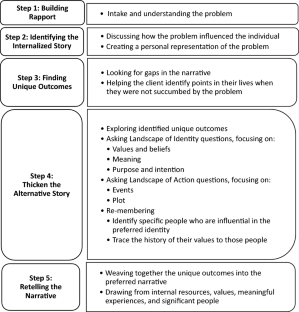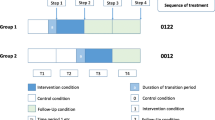Abstract
Research suggests that a clinical diagnosis of schizophrenia is strongly linked with experiencing negative stereotypes and an inability to recover. In challenging the scientific-logical practice of diagnostic labeling, which totalizes the person’s experience around the illness, Narrative therapy offers a unique approach to treating schizophrenia by putting the spotlight on the client’s values, strengths, and beliefs. This allows the client to discover an alternative life narrative beyond their diagnosis. This study presents a case of a 40-year-old woman with paranoid schizophrenia. She felt that the people in her workplace were out to harm her so she would never work in her field again. At home, she had also begun to question herself as a mother. Narrative therapy techniques such as externalization, thickening the landscape of action and identity, and re-membering were used to aid the client’s recovery and helped her to shift from a problematic view of her identity. The present case focuses on providing steps to guide practitioners in using Narrative therapy for a case where the client has internalized their diagnosis as their identity.

Similar content being viewed by others
Data Availability
The authors have no data or materials to declare that are relevant to the content of this article.
Code Availability
The authors did not use any software application and thus do not have a code.
Abbreviations
- DSM-5:
-
Diagnostic and Statistical Manual V
References
American Psychiatric Association (APA). (1994). Diagnostic and statistical manual of mental disorders (4th ed.). Washington DC: American Psychiatric Association.
American Psychiatric Association (APA). (2022). Diagnostic and statistical manual of mental disorders (5th ed., text rev.). https://doi.org/10.1176/appi.books.9780890425787
Beaudoin, M. (2005). Agency and choice in the face of trauma: A narrative therapy map. Journal of Systemic Therapies, 24(4), 32–50. https://doi.org/10.1521/jsyt.2005.24.4.32
Bullimore, P. (2003). Altering the balance of power: Working with voices. International Journal of Narrative Therapy and Community Work, 3, 22–28.
Carey, M., & Russell, S. (2002). Externalising: Commonly asked questions. International Journal of Narrative Therapy & Community Work, 2, 76–84.
Carr, A. (1998). Michael White’s Narrative Therapy. Contemporary Family Therapy, 20(4), 485–503.
Chae, Y., & Kim, J. (2015). Case study on narrative therapy for schizophrenic adolescents. Procedia—Social and Behavioral Science, 205, 53–55.
Corrigan, P. W., Watson, A. C., & Barr, L. (2006). The self-stigma of mental illness: Implications for self-esteem and self-efficacy. Journal of Social and Clinical Psychology, 25(8), 875–884. https://doi.org/10.1521/jscp.2006.25.8.875
Denborough, D. (2014). Retelling the stories of our lives: Everyday narrative therapy to draw inspiration and transform experience. W W Norton & Co.
Fung, K. M. T., Tsang, H. W. H., & Corrigan, P. W. (2008). Self-stigma of people with schizophrenia as predictor of their adherence to psychosocial treatment. Psychiatric Rehabilitation Journal, 32(2), 95–104. https://doi.org/10.2975/32.2.2008.95.104
Hasan, A. A. -H., & Musleh, M. (2018). Self-stigma by people diagnosed with schizophrenia, depression and anxiety: Cross-sectional survey design. Perspectives in Psychiatric Care, 54(2), 142–148. https://doi.org/10.1111/ppc.12213
Kinjo, T., & Morioka, M. (2011). Narrative responsibility and moral dilemma: A case study of a family’s decision about a brain-dead daughter. Theoretical Medicine and Bioethics, 32(2), 91–99. https://doi.org/10.1007/s11017-010-9160-y
Kondrat, D. C., & Teater, B. (2009). An anti-stigma approach to working with persons with severe mental disability: Seeking real change through narrative change. Journal of Social Work Practice, 23(1), 35–47. https://doi.org/10.1080/02650530902723308
Lloyd, H., Lloyd, J., Fitzpatrick, R., & Peters, M. (2017). The role of life context and self-defined well-being in the outcomes that matter to people with a diagnosis of schizophrenia. Health Expectations: An International Journal of Public Participation in Health Care and Health Policy, 20(5), 1061–1072. https://doi.org/10.1111/hex.12548
MacLeod, M. (2019). Using the narrative approach with adolescents at risk for suicide. Canadian Journal of Counselling and Psychotherapy, 53(1). Retrieved from https://cjc-rcc.ucalgary.ca/article/view/61213
Morgan, A. (2000). What is Narrative Therapy: An Easy to Read Introduction. Dulwich Center Publication.
Ngazimbi, E. E., Lambie, G. W., & Shillingford, M. A. (2008). The use of narrative therapy with clients diagnosed with bipolar disorder. Journal of Creativity in Mental Health, 3(2), 157–174. https://doi.org/10.1080/15401380802226661
Özçelik, E. K., & Yıldırım, A. (2018). Schizophrenia patients’ family environment, internalized stigma and quality of life. Journal of Psychiatric Nursing / Psikiyatri Hemsireleri Dernegi, 9(2), 80–87. https://doi.org/10.14744/phd.2017.07088
Sugawara, H., & Mori, C. (2018). The self-concept of person with chronic schizophrenia in Japan. Neuropsychopharmacology Reports, 38(3), 124–132. https://doi.org/10.1002/npr2.12016
White, M. (2005). Michael White workshop notes. Dulwich Centre. https://dulwichcentre.com.au/product/michael-whites-workshop-notes-michael-white/
White, M. (2007). Maps of narrative practice. W. W. Norton
White, M. (2011). Narrative practice: Continuing the conversations. (D. Denborough, Ed.). W W Norton & Co.
White, M. (2016). Chapter 1: Deconstruction and therapy. In Narrative Therapy Classics (pp. 11–54). Adelaide: Dulwich Centre Pty Ltd.
White, M., & Epston, D. (1990). Narrative means to therapeutic ends. W. W. Norton, New York
Acknowledgements
The authors would like to acknowledge the Ateneo Bulatao Center for its constant encouragement and support to advance academic research alongside clinical practice.
Funding
The authors did not receive support from any organization for the submitted work.
Author information
Authors and Affiliations
Contributions
All authors contributed to the study. Material preparation, data collection, and analysis were performed by Karina Therese G. Fernandez. The first draft of the manuscript was written by Karina Therese G. Fernandez, Anne Therese Marie B. Martin, and Dana Angelica S. Ledesma. All authors commented on previous versions of the manuscript. All authors read and approved the final manuscript.
Corresponding author
Ethics declarations
Conflicts of interest
The authors have no conflicts of interest to declare that are relevant to the content of this article.
Ethics Approval
This study received ethical approval from the University Research Ethics Office of the Ateneo de Manila University. This research study was conducted retrospectively from data obtained for clinical purposes. A copy of the approval letter has been provided in Appendix A.
Consent to Participate and Publication
In the informed consent given by the Ateneo Bulatao Center for Psychological Services to its therapy clients, there is a very detailed checklist of the extent of how their information can be used. One specific item is “session notes for the purposes of research (paper publications and paper presentations). We have attached a copy of an unsigned informed consent form for reference (see Appendix B).
Informed Consent
By signing an informed consent form, we obtained permission from the client to share her story. Furthermore, her identifying information was changed to ensure confidentiality. Though the informed consent form already covers the consent for data in the therapy sessions to be published, as recommended by informal discussions with members of the University Research Ethics Committee of the Ateneo de Manila University, a second request for informed consent to publish was made after therapy.
Additional information
Publisher's Note
Springer Nature remains neutral with regard to jurisdictional claims in published maps and institutional affiliations.
Rights and permissions
Springer Nature or its licensor (e.g. a society or other partner) holds exclusive rights to this article under a publishing agreement with the author(s) or other rightsholder(s); author self-archiving of the accepted manuscript version of this article is solely governed by the terms of such publishing agreement and applicable law.
About this article
Cite this article
Fernandez, K.T.G., Martin, A.T.M.B. & Ledesma, D.A.S. The Use of Narrative Therapy on Paranoid Schizophrenia. Psychol Stud 68, 273–280 (2023). https://doi.org/10.1007/s12646-022-00709-z
Received:
Accepted:
Published:
Issue Date:
DOI: https://doi.org/10.1007/s12646-022-00709-z




